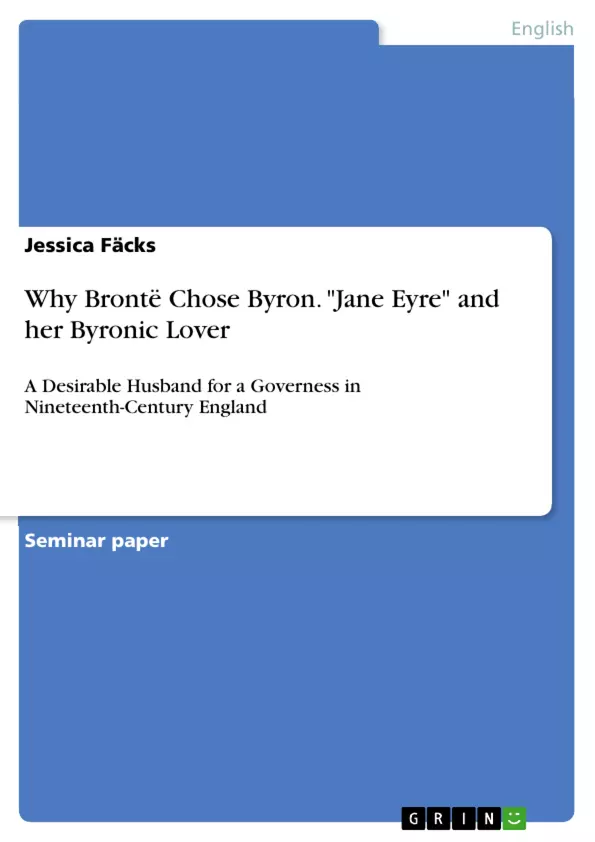165 years after its first publication in England, Charlotte Brontë’s “female Bildungsroman” (Gilbert and Gubar 339) "Jane Eyre" still prompts questions for both its readership and the literary scholars of today. Depicting the protagonist’s development from a poor orphan girl to a young governess who “yearns for true liberty” (Gilbert and Gubar 347), Brontë evokes a utopian ideal of a strong-minded heroine who defies social customs by marrying her master, Edward Fairfax Rochester. When pondering over Brontë’s comment to her publisher in 1848, “[t]he standard hero[e]s and heroines of novels are personages in whom I could never . . . take an interest, believe to be natural or wish to imitate: were I obliged to copy these characters, I would simply not write at all” (qtd. in Brennan 16), one can draw conclusions about Brontë’s intention to reward her heroine with Rochester, who is widely accepted as the epitome of a Byronic hero (cf. Wootton 231, Gilbert and Gubar 337) – a “unique” (Thorslev 12) hero whose name re-fers to its real-life impersonator, the English Romantic poet George Gordon “Lord” Byron.
As this paper is concerned with the question whether the Byronic hero embo-dies the desirable husband for a governess in nineteenth-century England, a brief overview of the reception of Byron and his works as a “cultural phenomenon” (Elfenbein 47) during Brontë’s time seems necessary and will be dealt with in the first part of this pa-per. Andrew Elfenbein’s study Byron and the Victorians from 1995 serves as a valuable source which particularly considers Byron’s female readership and offers reasons for his popularity among them.
Since most scholars view Rochester as a Byronic hero while merely focussing on his physiognomy (cf. Wootton 231), the second part of this paper draws comparisons between Rochester’s character and the main features of a Byronic hero, as Peter L. Thorslev Jr. framed him in depth in his study The Byronic Hero: Types and Prototypes from 1962. In the third and last part of this paper, the social context of women in ge-neral and governesses in particular with due regard to love, marriage and legal rights will be taken into account. It will be argued that a marriage despite gender and social borders is enabled between the governess Jane and her master Rochester by making the latter Byronic, whereby Rochester becomes the epitome of a desirable husband for a governess in nineteenth-century England.
Inhaltsverzeichnis (Table of Contents)
- Introduction
- The Reception of Byron's Works in Nineteenth-Century England
- Rochester as a Byronic Hero and his Relevance for Jane Eyre
- Unfulfilled Desires of Governesses in Nineteenth-Century England
- Conclusion: Why Brontë Chose Byron
Zielsetzung und Themenschwerpunkte (Objectives and Key Themes)
This paper explores the significance of the Byronic hero in Charlotte Brontë's Jane Eyre, analyzing how Rochester embodies the characteristics of a Byronic hero and how this portrayal contributes to his attractiveness as a husband for a governess in nineteenth-century England. The paper examines the reception of Byron's works in Brontë's time, particularly among women, and delves into the social context of governesses and their limited opportunities in terms of love, marriage, and legal rights. It argues that the Byronic traits attributed to Rochester enable a transgression of social and gender boundaries in the relationship between Jane and Rochester, making him a desirable husband for a governess.
- The Byronic hero as a cultural phenomenon in nineteenth-century England
- Rochester as a Byronic hero in Jane Eyre
- The social constraints faced by governesses in nineteenth-century England
- The role of the Byronic hero in challenging social norms and empowering female characters
- The intersection of gender, class, and power in the relationship between Jane and Rochester
Zusammenfassung der Kapitel (Chapter Summaries)
- Introduction: This chapter introduces the paper's central question concerning the desirability of the Byronic hero as a husband for a governess in nineteenth-century England. It highlights the enduring relevance of Jane Eyre and its portrayal of the protagonist's journey. The chapter then outlines the paper's structure, focusing on the reception of Byron's works, Rochester's characteristics as a Byronic hero, and the social context of governesses in nineteenth-century England.
- The Reception of Byron's Works in Nineteenth-Century England: This chapter explores the widespread popularity of Byron and his works during the nineteenth century, considering both his biography and his literary creations. It analyzes how Byron's works resonated with various social classes, particularly among women, who found in his heroes a reflection of their own unfulfilled desires and a means of escaping the constraints of Victorian society. The chapter discusses the commercial exploitation of Byron's image and the identification of women with his heroes, suggesting a potential for challenging gender norms through the lens of Byron's romanticism.
- Rochester as a Byronic Hero and his Relevance for Jane Eyre: This chapter examines Rochester's character in Jane Eyre through the lens of the Byronic hero. It analyzes his features and actions, contrasting them with conventional heroic figures and exploring how Brontë subverts traditional gender roles through their interaction. The chapter discusses the influence of Byron's work on Brontë's portrayal of Rochester, highlighting how his Byronic attributes contribute to his attractiveness as a love interest for Jane.
Schlüsselwörter (Keywords)
This paper delves into the key themes of the Byronic hero, gender roles, social constraints, romanticism, Victorian literature, and the portrayal of governesses in nineteenth-century England. It focuses on Charlotte Brontë's Jane Eyre and its interpretation of Byron's influence on the character of Rochester, emphasizing the intersection of gender, class, and power in their relationship. The paper examines the reception of Byron's works and their impact on societal expectations and the portrayal of female characters in literature.
- Quote paper
- Jessica Fäcks (Author), 2012, Why Brontë Chose Byron. "Jane Eyre" and her Byronic Lover, Munich, GRIN Verlag, https://www.grin.com/document/229603




